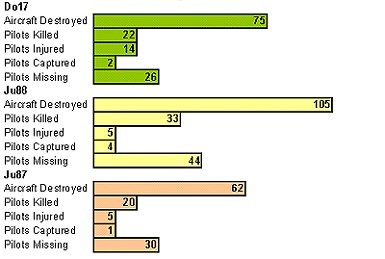

Although the above graph shows that German losses during this month were very high, they appear even worse when we take the total German strength and convert the above figures into percentages. The single engined Bf109 figures represent 24% of the total fighter strength while the bombers represent a total of 19% of the bomber strength. Concern to the Luftwaffe was the high casualty rate of pilots and crew, which had to have an impact on morale of aircrew of the German Air Force.
The month previous, when the Luftwaffe was content on attempting to draw the Royal Air Force into combat over the English Channel, figures were far fewer than those shown above for the month of August 1940 when more serious attempts were being made on targets over Britain itself.
| . AIRCRAFT | STRENGTH May 1st 1940 | STRENGTH June 30th 1940 |
| Reconnaissance | 670 | 569 |
| Bf109 Fighters | 1,369 | 1,107 |
| Bf110 Fighter/Bombers | 367 | 357 |
| Medium/Heavy Bombers | 1,758 | 1,380 |
| Dive Bombers | 417 | 428 |
In looking at the above table, not only must we compare the strength under both dates and see that the strength had been drastically reduced by June 30th 1940, but we must also take into consideration that between the two dates shown, additional new aircraft would have come out of the factories. So if we take the Bf109 for instance, the table shows a difference of 262. If 350 new Bf109s had come from the factories, that, in actual fact shows that 612 Bf109s were destroyed. Unfortunately no details of replacement German aircraft were available at the time of writing, so there would be an inaccuracy in the last example, but you should get the general idea.
So it can be understood as to why the German Air Ministry was concerned with the number of losses that were occuring. What made things worse, when we look at the number of aircraft damaged in non-combat operations. In the May - June period of 1940, and we must appreciate that the air war was not yet at its climax, 33 Bf109 fighters were damaged due to enemy action, yet 92 were damaged due to non-enemy action, while 66 were destroyed due to non-enemy action. A figure in excess of the total losses of the RAF during the same period.
But things were not to get any better. In a later document, when looking at the total damages and losses of the Luftwaffe, we shall see that as the Battle of Britain wears on, things do not improve for the Luftwaffe, and it was not just the German fighter strength that suffered.
The figures shown above are based on the figures published in The Luftwaffe - Strategy For Defeat by Williamson Murray published by Chartwell Books 1986.

